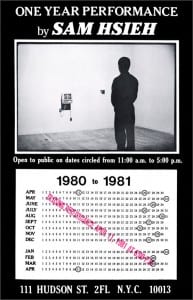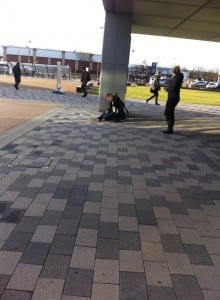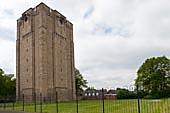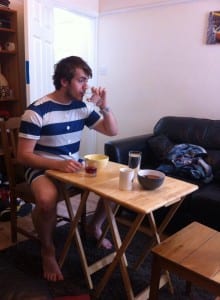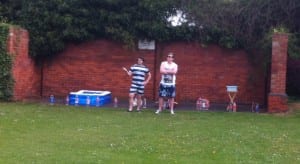For our site specific performance we took initial inspiration from repetition and endurance artists and practitioners such as Sam Hsieh as well as Burrows and Fargion. The the way he uses his focus to make every day repetitive actions interesting to a watching audience. Of his performance pieces, there was one that stood out and that we have drawn influences from when considering how to base our performance, and this is his year long piece called “Time Clock Piece” (FACT, 2010). The main aspect that we liked when looking at this performance was the seemingly remedial task of repeating a repetitive action for a long period of time.
This idea of performing menial tasks over and over again appealed to myself and my colleague, however we felt like we needed a central theme in order to base these actions upon. This is when we came across the water tower in Lincoln, we decided that this theme of water was general enough to cover a range of actions that we could perform as well as being site specifically linked to the water tower in Wickham Gardens. When we were studying repetitive actions we could do in a performative way, we discovered two pieces from Jonathan Burrows and Matteo Fargion which can be found here.
https://www.youtube.com/watch?v=HyWwmHrmpxM
https://www.youtube.com/watch?v=vqJ-kQwxfFI
Their simple yet somehow intriguing movements showed us that whatever movements we chose to do, as long as we them on point and with focus, it would become an interesting performance to watch which was one of our main worries.
Our performance would be devised into five stations that each would last for an hour. This would be followed by a transition to the next station in which we could pack up the things from the previous station and start on assembling the new one. This five stations, in chronological order, would be:
1. Brushing teeth and washing face – one of use doing each action a in pre-arranged set of movements e.g. washing left cheek then right, then forehead, then chin before ending the set with drying your face and repeating. We would switch every fifteen minutes to prevent our faces/gums becoming irritated.
2. Washing clothes – my colleague would wash the clothes and put them on the climbing frame that we would use as a washing line. I would then put the wet clothes on and dirty them by playing the nearby park and rolling down the hill. I would then pass the dirty clothes to my colleague, thus completing a set.
3. Eating and drinking – we would eat and drink water based products such as soup, squash and also tea and coffee. This would also be in a pre-arranged set of movements e.g. lift cup to face, drink, put down again.
4. Washing dishes – now we would wash and dry the dishes that we had previously used and wash and dry them very slowly, this would represent the passage of time that seems to happen when people do this mundane task.
5. Bathing – lastly, we would bath in a paddling pool that we had brought and spend 15 minutes washing each others backs before swapping over.
This performance would take place at Wickham gardens in Lincoln between 10:00 and 15:00 on the 6th May 2015. We did not expect any audience interaction as our performance was not based upon it, we only expected them to observe.
When first hearing about site specific performance, I have to say it was somewhat daunting. Not in the public performances, as embarrassment isn’t something that comes naturally to me but re-thinking what a site can mean, do or how it can influence a performance challenged my preconceptions. To me before this module, a site was just a relevant background to a pre-established text i.e. Macbeth in a gloomy castle. However, whilst reading Mike Pearson’s Site-Specific Performance, I found many ideas and alternative ways of looking at things that opened my eyes to new ideas and the ambiguous characteristics that sites can have. “Not only does the use of non-theatre venues contribute to ‘an inquiry into what theatre is and might be’ it also incorporates ‘a set of productive spacial metaphors'” (Pearson, 2010. p.9). I then learnt about subtle mobs, an interesting idea but wasn’t really something that leaped out and grabbed my attention. I did however have a lot of fun in doing it and my colleague and I definitely took inspiration from the fun element of site specific and this is where we first had the idea of doing a performance in a public park, an idea which we would then later establish on. Here though, is a picture of my first day doing a site specific performance.
The next site specific lesson would cover the idea of a misguide, a guided tour that would offer an alternative look on places that seemed fairly ordinary. This again was an interesting idea and was the first time I’d looked into the idea of rich and poor sites as misguided tours would need rich sites to take the alternative ideas from, a poor site would either be uninteresting or of such little value that the people on this tour wouldn’t care about either viewpoint. I looked into this notion of rich and poor sites further and discovered a piece of text by Govan et al which uses the term ‘place’ and ‘non-place’ to describe the quality of a site and states that there are: “places which are rich in history and non-places which he see’s as soulless, alienating places with only functional value such as airports and motorways” (Govan et al, 2007, p.121). I therefore wanted to perform in a place which had historical significance and fortunately in Lincoln there are many to choose from such as the cathedral or the castle. However, we thought these places, whilst significant and beautiful, would be an altogether safe and predictable place to perform in so we wanted somewhere where it would be both fun to perform there for have some element of fun involved but was also historically significant.
We stumbled upon our eventual location for the performance quite by accident as during the misguided tours lesson, we ended up following a dog and it’s owner as we had an initial idea about incorporating animals or animal rights somehow into our performance (an idea what was later scrapped due to difficulties this would present with reliability). Whilst following this dog be came across an abandoned children’s park situated right next to the Lincoln water tower. We then had an epiphany and decided that this site covered all the areas so far that we wanted, it had the fun element of the former playground and the historical element of the water tower and set about learning the history of both of these places.
When I read about this history of the water tower I was shocked to discover just how important it has been in Lincoln’s history and yet many people, myself included, had no idea what it was for or why it was even built. It was built in the early 1900s to stop an outbreak of typhoid that had swept over the city and gave the local people clean water to drink and use in their day to day lives and the outbreak was eventually cleared. We then talked to out tutor who has lived in Lincoln and asked about her personal experiences with the park and we got plenty of local knowledge about how what the park used to be like and how much it’s changed over the years. For instance, the park used to have a sandpit opposite it, a route through the park known as the ‘Jungle Run’ as well as a hill that was specifically known as the ‘Rolling Hill’ by children using the park in the 1980’s. We wanted to incorporate at least one of these into our performance as it would give reference to the playground and the feeling of fun that used to be here that unfortunately is no longer. We also discovered that the site where we’ll be performing used to host a number of water related environments, including a public swimming pool and a public bath. We wanted to use one of these environments, as well as the playground in our performance as the history of our site was one of our developing themes of the performance.
After learning more about our site, we then focused on what sort of performance we wanted to do and what we wanted to achieve from it. When we were researching previous performances from which to take inspiration, my colleague found a piece by the artist and performer Sam Hsieh. It involved him performing a task or series of tasks for a whole year and this sparked an idea.
“Why don’t we do an endurance piece?”
This would be a problem for a few reasons as it turned out, first and chief among which was the problem of time, we only had one day to perform this as our performance day was set on the 6th May so an endurance challenge like Hsieh’s was quickly thought better of. Another problem we found was that health and safety had to be taken into account as the university was responsible for our well-being whilst in class or performing and doing tasks that are potentially dangerous for an extended period of time wasn’t going to be possible either.
We wanted our site specific piece to still be performative though so we eventually settled on doing a repetitive theatre piece. Our tutor then pointed us in the direction of Burrows and Fargion, a pair of performers who specialize in this particular field of theatre and we found videos of Hands and Both Sitting Duet on Youtube. We wanted to incorperate something like Hands in particular into one of our stations and after seeing these videos and drawing inspiration from our research as well as our site, we set about devising our performance.
When in the site we discovered five sections of ground that clearly used to have playground things in them such as a swingset, roundabout etc. and we wanted to use as our frames for each station.
We did have a brief idea about framing the water tower itself but this would of complicated the performance and we decided against it but did want to use the tower itself for something but we didn’t know what yet. As there were five sections it made sense to have five stations, each one representing something that we would do every day that involves water. Taking inspiration from Barrows and Fargion, we would use repetitive movements to perform at each station. Whilst in our site, we discovered that as we were planning what we’d do in each station the shadow of the water tower acted as a large sun dial and this gave us the idea of doing the mundane tasks we do every day in chronological order so as the time past in our performance, the real passage of time would also reflect how long we spend doing these tasks in our everyday lives and that we take for granted the clean water that this available to us. After much discussion between ourselves and our tutor we settled on these five stations:
1. Brushing teeth and washing face.
2. Washing clothes
3. Eating and drinking
4. Washing Dishes
5. Bathing
We settled on these because it’s what we use water for every day but also because we could incorporate some of the research we used and apply them to these particular stations. For instance, for our washing clothes station we thought that we could use the ‘Rolling Hill’ to dirty the clothes so that they could be washed again and complete a set. For the eating and drinking station we could take inspiration from Hands and do movements that just involve our hands and mouths completing a set before the next person would then complete theirs and so on. For the washing the dishes we really wanted to emphasize the water tower as a sun dial by slowing down time in our performance and show how boring this action is yet we take the water we do it in for granted.
After figuring out which station would go where and when, we thought that the best thing to do would be just the practice doing the movement for an hour and this was a lot harder than we thought it would be. My colleague tried to film himself performing brushing his teeth for an hour but could only do 25 minutes before encountering problems and this video of this can be found here:
https://www.youtube.com/watch?v=xErlJtAjc4s
(Dunn, 2015)
The main issue is that after brushing for so long his gums would start to hurt so to get around this issue we decided that we would switch roles so that none of us would be either brushing our teeth or rubbing our face for too long. Some of the stations proved easier to do for an hour than others, our eating and drinking station was by far our easiest station despite the concentration and focus we used on the movements.
(Dunn, 2015)
After doing these rehearsals we found that no matter how hard we tried we could never do the same movement perfectly every time and this led me to do some research into this and ask the question?
“Is failure part of performance, is the audience as interested in failure as success and are these failures just a section of the humanity of performance?”
After researching this topic I discovered that “No repetition is exactly the same as the action as it copies – if only by the fact of it being a repetition rather than an initial act, or of being the third repetition rather than the second.” (Howell, 1999). This quote from Howell shows that in repetitive theatre, no repetition will be the same and that the failures in the performance will be just as important as the successful movements. Obviously, we would try our very best to ensure that the next set of movements is as perfectly copied as the last but we knew that this wouldn’t always be the case in a piece of repetitive theatre.
As our final rehearsal loomed large, we encountered some last minute problems that needed addressing. The main problem was that we would find it difficult collecting enough water for each of our stations and the transportation of some of out larger props, such as the tables and chairs for the eating/drinking station and the paddling pool for our last station. We got around this by asking our friends at university to keep all their bottles that they had used over the past weeks and give them to us instead of throwing them out so that we could fill them with enough water to ensure we wouldn’t run out on the performance day. We also made several trips to and from the site in one of our friends car to transport the props and found that on the day we’d have to be up and at our site starting from 08:30 to ensure that we were ready to start on the dot of 10:00. Aside from those problems the last rehearsal went very well with no further problems and we we’re looking forward to performance day. We decided to entitle our performance piece This is Water. The name is in reference to a speech given by the author David Foster Wallace at Kenyon College in Ohio in 2005. The speech he gave references the mundane actions of every life, and the ‘day in and day out’ routines that we all experience.
(Crowe, Dunn, 2015)
Overall our performance day went very well but we unfortunately had to cut the performance short early due to health and safety concerns. This was because of the weather conditions taking it’s toll on our performance and meant that stations such as putting the wet clothes on and off again as well as sitting in a cold paddling pool for an hour was ill-advised and unfortunately we had to put an end to our performance at approximately 12:30. Fortunately the audience interaction we did get was positive with a couple of confused faces but that was to be expected. However we did put up notices around the park stating that there was a performance going on but that they should feel free to still use the park.
After the performance was over we discovered that we could of further improve the integrity of our performance by instead of using tap water which we had gathered, we could of used rain water and then then purified it, thus symbolizing the purification of water that the water tower does. We also could of put on our signs what specifically the performance was about and it’s significance to the water tower as well as the playground. This is because we realised that people from Lincoln that know about the water tower would make the link between what we were doing and the site but people that don’t know about Lincoln’s history wouldn’t understand the depth behind the performance and should we do this performance again, this is an area in which we can improve on.
Overall, the stations went well and exactly as we expected so we felt like the integrity of our performance was one of the best things about it as well as the focus that we gave to each movement at each station. The integrity of site specific performance and art is the main thing that attracts it to me and my understanding of performance in a non traditional theatre format has been both challenged and deepened considerably. Practitioners such as Pearson and performers such as Burrows and Fargion as well as Hsieh have inspired me to do this performance and has given be a new insight into what performance can be, it could be a West End musical but it could be something as simple as brushing your teeth.
Works referenced:
Burrows, J. Fargion, M. (2002) Both Sitting Duet [performance]. Available from https://www.youtube.com/watch?v=HyWwmHrmpxM
Burrows, J. Fargion, M. (1995) Hands [performance]. BBC Arts council. London. Available from https://www.youtube.com/watch?v=vqJ-kQwxfFI
Crowe. S. (2015) Water tower picture [image]. Lincoln
Crowe, S. Dunn, J. (2015) Performance Day [image]. Lincoln
Crowe, S. Dunn, J. (2015) Mapping out the site [image]. Lincoln
Dunn, J. (2015) Site Specific Performance Rehearsals [image]. Lincoln
Dunn, J. (2015) Endurance Performance “Rehearsal” [online video] Available from https://www.youtube.com/watch?v=xErlJtAjc4s [Accessed 16th April 2015].
FACT (2008) Tehching Hsieh – One Year Performance 1980 1981 (Time Clock Piece) [online video] Available from https://vimeo.com/16280427 [Accessed 27 March 2015].
Govan, E. Nicholson, H. Normington, K. (2007) Making a performance: Devising Histories and contemporary practises. Oxon: Routledge.
Howell, A. 1999. The Analysis of Performance Art: A Guide to Its Theory and Practice.Routledge. p.79
Hsieh, T. (1980) One Year Performance. [online] New York, USA: Tehching Hsieh. Available from https://colaboratorioartandspace.wordpress.com/2011/01/28/tehching-hsieh-art-live-in-action/ [Accessed 15th April 2015].
Pearson, M. (2010). Site-Specific Performance, Palgrave Macmillan, p.9
Rachel Baynton Group (2015) Subtle Mob [performance] Lincoln: Lincoln Campus, 28th January.

